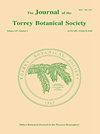The role of canopy gaps in maintaining vascular plant diversity at a forested wetland in New York State1
IF 0.8
4区 生物学
Q4 PLANT SCIENCES
引用次数: 49
Abstract
conifer swamp. Our study site, Nelson Swamp, has high documented species richness and supports a large number of state-protected species. Understory cover and species richness at both the quadrat and gap scale were compared among closed canopy areas and gaps in three size classes. To assess differences in the understory environment among the three size classes, we compared light, hydrology, and microtopography. We also tested for correlations between gap species richness and light, wetness, and microsite heterogeneity to determine which aspects of the gap environment might influence vascular plant diversity therein. There was higher quadrat- and gap-level species richness in gaps than in closed canopy areas. Small gaps did not appear to offer a physical environment substantially different from non-gaps, as no differences in their understory communities were apparent. Mid-sized and large gaps had higher species richness, substrate heterogeneity, and water table fluctuation than small gaps. Based on the correlations, the individual factors influencing species richness at the gap scale were depth to water, water level fluctuation, and microtopographic variability, indicating the importance of hydrology over light as a species control. Although gaps and non-gaps shared many of the same species, there were distinct subsets of species that were more important in either type of community. Based on these subsets, closed canopy areas and large gaps can be viewed as two ends of a continuum corresponding to light and hydrology gradients. Out of all the species encountered, 10 percent were found exclusively in gaps, and none were found only under closed canopy. Thus, these gaps are not only sites of higher overall plant growth, but also areas that allow rare species to persist.纽约州森林湿地冠层间隙在维持维管植物多样性中的作用[j]
针叶树沼泽。我们的研究地点尼尔森沼泽有很高的物种丰富度和大量的国家保护物种。在样方尺度和林隙尺度上比较了3个大小等级的林冠封闭区和林隙的林下盖度和物种丰富度。为了评估三种大小类型林下环境的差异,我们比较了光照、水文和微地形。我们还测试了林隙物种丰富度与光照、湿度和微站点异质性之间的相关性,以确定林隙环境的哪些方面可能影响其中的维管植物多样性。样方水平和林窗水平的物种丰富度均高于封闭林冠区。小林隙与非林隙的自然环境差异不大,林隙的林下群落没有明显差异。中型和大型林隙的物种丰富度、基质异质性和地下水位波动均高于小型林隙。基于相关性,影响间隙尺度上物种丰富度的个体因子为水深、水位波动和微地形变异性,表明水文在物种控制中的重要性高于光照。尽管林隙和非林隙共享许多相同的物种,但在两种类型的群落中都有不同的物种亚群。基于这些子集,封闭的冠层面积和大间隙可以看作是对应于光和水文梯度的连续统的两端。在所有遇到的物种中,10%的物种只在间隙中发现,没有一个物种只在封闭的树冠下发现。因此,这些间隙不仅是植物总体生长较高的地方,而且是允许稀有物种持续存在的地区。
本文章由计算机程序翻译,如有差异,请以英文原文为准。
求助全文
约1分钟内获得全文
求助全文
来源期刊
CiteScore
0.70
自引率
0.00%
发文量
16
审稿时长
>12 weeks
期刊介绍:
The Journal of the Torrey Botanical Society (until 1997 the Bulletin of the Torrey Botanical Club), the oldest botanical journal in the Americas, has as its primary goal the dissemination of scientific knowledge about plants (including thallopyhtes and fungi). It publishes basic research in all areas of plant biology, except horticulture, with an emphasis on research done in, and about plants of, the Western Hemisphere.

 求助内容:
求助内容: 应助结果提醒方式:
应助结果提醒方式:


